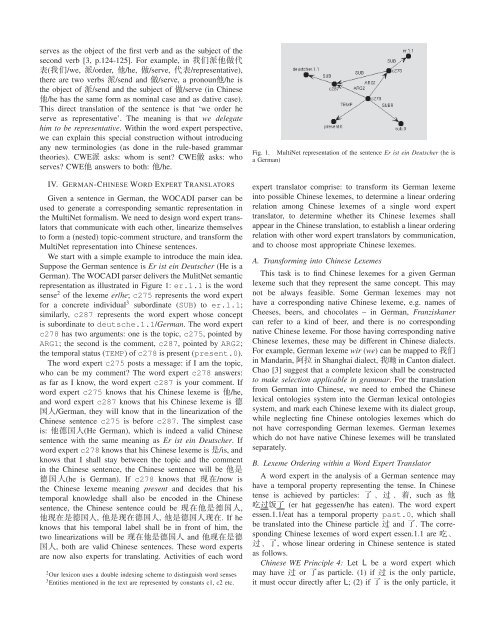Word Expert Translation from German into Chinese in - Knowledge ...
Word Expert Translation from German into Chinese in - Knowledge ...
Word Expert Translation from German into Chinese in - Knowledge ...
Create successful ePaper yourself
Turn your PDF publications into a flip-book with our unique Google optimized e-Paper software.
serves as the object of the first verb and as the subject of the<br />
second verb [3, p.124-125]. For example, <strong>in</strong> ������<br />
�(��/we, �/order, �/he, �/serve, ��/representative),<br />
there are two verbs �/send and �/serve, a pronoun�/he is<br />
the object of �/send and the subject of �/serve (<strong>in</strong> <strong>Ch<strong>in</strong>ese</strong><br />
�/he has the same form as nom<strong>in</strong>al case and as dative case).<br />
This direct translation of the sentence is that ‘we order he<br />
serve as representative’. The mean<strong>in</strong>g is that we delegate<br />
him to be representative. With<strong>in</strong> the word expert perspective,<br />
we can expla<strong>in</strong> this special construction without <strong>in</strong>troduc<strong>in</strong>g<br />
any new term<strong>in</strong>ologies (as done <strong>in</strong> the rule-based grammar<br />
theories). CWE� asks: whom is sent? CWE� asks: who<br />
serves? CWE� answers to both: �/he.<br />
IV. GERMAN-CHINESE WORD EXPERT TRANSLATORS<br />
Given a sentence <strong>in</strong> <strong>German</strong>, the WOCADI parser can be<br />
used to generate a correspond<strong>in</strong>g semantic representation <strong>in</strong><br />
the MultiNet formalism. We need to design word expert translators<br />
that communicate with each other, l<strong>in</strong>earize themselves<br />
to form a (nested) topic-comment structure, and transform the<br />
MultiNet representation <strong><strong>in</strong>to</strong> <strong>Ch<strong>in</strong>ese</strong> sentences.<br />
We start with a simple example to <strong>in</strong>troduce the ma<strong>in</strong> idea.<br />
Suppose the <strong>German</strong> sentence is Er ist e<strong>in</strong> Deutscher (He is a<br />
<strong>German</strong>). The WOCADI parser delivers the MulitNet semantic<br />
representation as illustrated <strong>in</strong> Figure 1: er.1.1 is the word<br />
sense2 of the lexeme er/he; c275 represents the word expert<br />
for a concrete <strong>in</strong>dividual3 subord<strong>in</strong>ate (SUB) to er.1.1;<br />
similarly, c287 represents the word expert whose concept<br />
is subord<strong>in</strong>ate to deutsche.1.1/<strong>German</strong>. The word expert<br />
c278 has two arguments: one is the topic, c275, po<strong>in</strong>ted by<br />
ARG1; the second is the comment, c287, po<strong>in</strong>ted by ARG2;<br />
the temporal status (TEMP)ofc278 is present (present.0).<br />
The word expert c275 posts a message: if I am the topic,<br />
who can be my comment? The word expert c278 answers:<br />
as far as I know, the word expert c287 is your comment. If<br />
word expert c275 knows that his <strong>Ch<strong>in</strong>ese</strong> lexeme is �/he,<br />
and word expert c287 knows that his <strong>Ch<strong>in</strong>ese</strong> lexeme is �<br />
��/<strong>German</strong>, they will know that <strong>in</strong> the l<strong>in</strong>earization of the<br />
<strong>Ch<strong>in</strong>ese</strong> sentence c275 is before c287. The simplest case<br />
is: ����(He <strong>German</strong>), which is <strong>in</strong>deed a valid <strong>Ch<strong>in</strong>ese</strong><br />
sentence with the same mean<strong>in</strong>g as Er ist e<strong>in</strong> Deutscher. If<br />
word expert c278 knows that his <strong>Ch<strong>in</strong>ese</strong> lexeme is �/is, and<br />
knows that I shall stay between the topic and the comment<br />
<strong>in</strong> the <strong>Ch<strong>in</strong>ese</strong> sentence, the <strong>Ch<strong>in</strong>ese</strong> sentence will be ��<br />
���(he is <strong>German</strong>). If c278 knows that ��/now is<br />
the <strong>Ch<strong>in</strong>ese</strong> lexeme mean<strong>in</strong>g present and decides that his<br />
temporal knowledge shall also be encoded <strong>in</strong> the <strong>Ch<strong>in</strong>ese</strong><br />
sentence, the <strong>Ch<strong>in</strong>ese</strong> sentence could be �������,<br />
�������, �������, �������. Ifhe<br />
knows that his temporal label shall be <strong>in</strong> front of him, the<br />
two l<strong>in</strong>earizations will be ������� and �����<br />
��, both are valid <strong>Ch<strong>in</strong>ese</strong> sentences. These word experts<br />
are now also experts for translat<strong>in</strong>g. Activities of each word<br />
2 Our lexicon uses a double <strong>in</strong>dex<strong>in</strong>g scheme to dist<strong>in</strong>guish word senses<br />
3 Entities mentioned <strong>in</strong> the text are represented by constants c1, c2 etc.<br />
Fig. 1. MultiNet representation of the sentence Er ist e<strong>in</strong> Deutscher (he is<br />
a <strong>German</strong>)<br />
expert translator comprise: to transform its <strong>German</strong> lexeme<br />
<strong><strong>in</strong>to</strong> possible <strong>Ch<strong>in</strong>ese</strong> lexemes, to determ<strong>in</strong>e a l<strong>in</strong>ear order<strong>in</strong>g<br />
relation among <strong>Ch<strong>in</strong>ese</strong> lexemes of a s<strong>in</strong>gle word expert<br />
translator, to determ<strong>in</strong>e whether its <strong>Ch<strong>in</strong>ese</strong> lexemes shall<br />
appear <strong>in</strong> the <strong>Ch<strong>in</strong>ese</strong> translation, to establish a l<strong>in</strong>ear order<strong>in</strong>g<br />
relation with other word expert translators by communication,<br />
and to choose most appropriate <strong>Ch<strong>in</strong>ese</strong> lexemes.<br />
A. Transform<strong>in</strong>g <strong><strong>in</strong>to</strong> <strong>Ch<strong>in</strong>ese</strong> Lexemes<br />
This task is to f<strong>in</strong>d <strong>Ch<strong>in</strong>ese</strong> lexemes for a given <strong>German</strong><br />
lexeme such that they represent the same concept. This may<br />
not be always feasible. Some <strong>German</strong> lexemes may not<br />
have a correspond<strong>in</strong>g native <strong>Ch<strong>in</strong>ese</strong> lexeme, e.g. names of<br />
Cheeses, beers, and chocolates – <strong>in</strong> <strong>German</strong>, Franziskaner<br />
can refer to a k<strong>in</strong>d of beer, and there is no correspond<strong>in</strong>g<br />
native <strong>Ch<strong>in</strong>ese</strong> lexeme. For those hav<strong>in</strong>g correspond<strong>in</strong>g native<br />
<strong>Ch<strong>in</strong>ese</strong> lexemes, these may be different <strong>in</strong> <strong>Ch<strong>in</strong>ese</strong> dialects.<br />
For example, <strong>German</strong> lexeme wir (we) can be mapped to ��<br />
<strong>in</strong> Mandar<strong>in</strong>, �� <strong>in</strong> Shanghai dialect, �� <strong>in</strong> Canton dialect.<br />
Chao [3] suggest that a complete lexicon shall be constructed<br />
to make selection applicable <strong>in</strong> grammar. For the translation<br />
<strong>from</strong> <strong>German</strong> <strong><strong>in</strong>to</strong> <strong>Ch<strong>in</strong>ese</strong>, we need to embed the <strong>Ch<strong>in</strong>ese</strong><br />
lexical ontologies system <strong><strong>in</strong>to</strong> the <strong>German</strong> lexical ontologies<br />
system, and mark each <strong>Ch<strong>in</strong>ese</strong> lexeme with its dialect group,<br />
while neglect<strong>in</strong>g f<strong>in</strong>e <strong>Ch<strong>in</strong>ese</strong> ontologies lexemes which do<br />
not have correspond<strong>in</strong>g <strong>German</strong> lexemes. <strong>German</strong> lexemes<br />
which do not have native <strong>Ch<strong>in</strong>ese</strong> lexemes will be translated<br />
separately.<br />
B. Lexeme Order<strong>in</strong>g with<strong>in</strong> a <strong>Word</strong> <strong>Expert</strong> Translator<br />
A word expert <strong>in</strong> the analysis of a <strong>German</strong> sentence may<br />
have a temporal property represent<strong>in</strong>g the tense. In <strong>Ch<strong>in</strong>ese</strong><br />
tense is achieved by particles: � � � � �, such as �<br />
���� (er hat gegessen/he has eaten). The word expert<br />
essen.1.1/eat has a temporal property past.0, which shall<br />
be translated <strong><strong>in</strong>to</strong> the <strong>Ch<strong>in</strong>ese</strong> particle � and �. The correspond<strong>in</strong>g<br />
<strong>Ch<strong>in</strong>ese</strong> lexemes of word expert essen.1.1 are ��<br />
���, whose l<strong>in</strong>ear order<strong>in</strong>g <strong>in</strong> <strong>Ch<strong>in</strong>ese</strong> sentence is stated<br />
as follows.<br />
<strong>Ch<strong>in</strong>ese</strong> WE Pr<strong>in</strong>ciple 4: Let L be a word expert which<br />
may have � or �as particle. (1) if � is the only particle,<br />
it must occur directly after L; (2) if � is the only particle, it

















